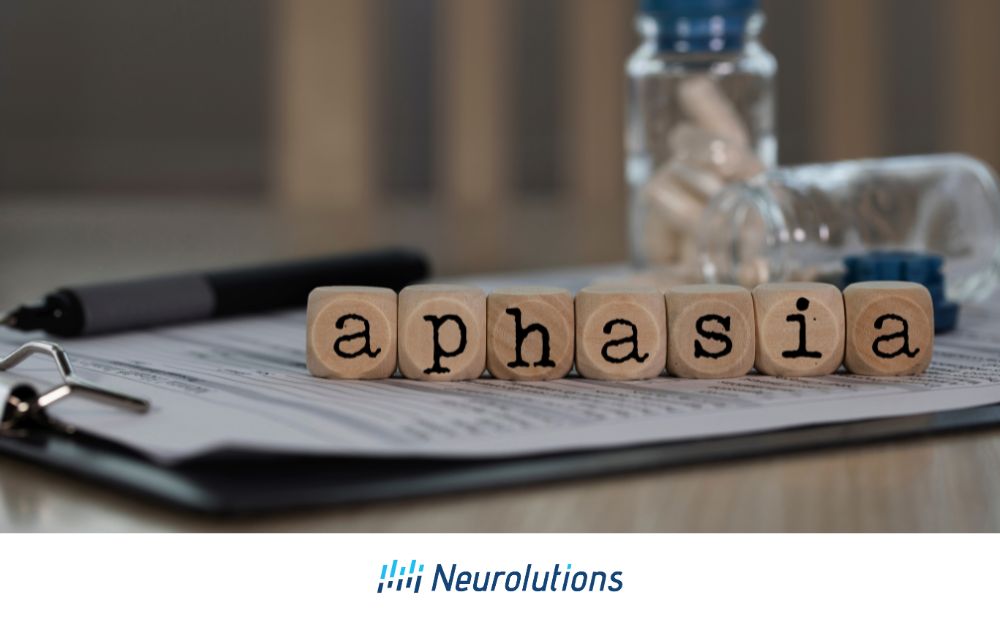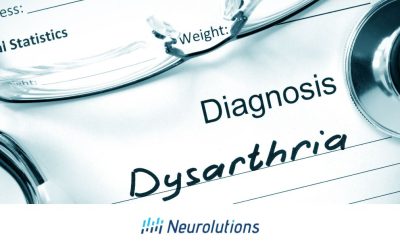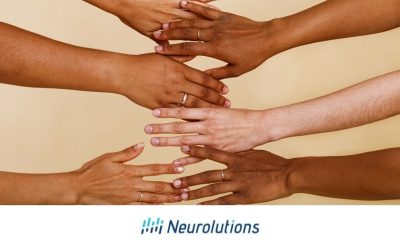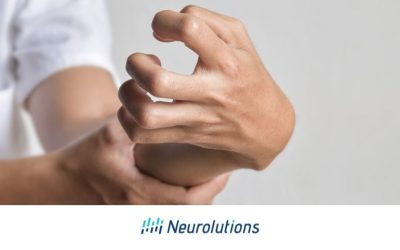Introduction
Aphasia is a condition that affects a person’s ability to communicate. It can impact a person’s speech, their ability to understand spoken language, as well as their reading and writing skills. Aphasia often occurs due to a stroke or Traumatic Brain Injury (TBI) when the brain areas responsible for speech and language become damaged. These injuries can also lead to muscle paralysis, making it even harder for a person to communicate.
Each year, between 100,000-180,000 people in the US are diagnosed with aphasia (1). There are three main types of aphasia, and the treatment depends largely upon the type. Some people may be diagnosed with more than one type, making recovery more difficult. While occupational and physical therapy (OT and/or PT) is often implemented post-stroke to help people regain muscle movements and motor skills, speech-language pathologists (SLP) are crucial in helping those with aphasia improve their communication abilities (2).
The following article will describe the different types of aphasia, how it can affect a person’s communication abilities, and the treatment options that can help a person regain independence and quality of life.
How Does a Stroke or Traumatic Brain Injury (TBI) Cause Aphasia?
A stroke or traumatic brain injury may damage the brain areas responsible for communication, which leads to aphasia.
As a consequence of a stroke or a TBI, the appearance of a blood clot or bleeding in the brain can lead to the disruption of nerve communication pathways and damage to the brain itself.
The brain’s cerebrum, the largest part of the brain, is divided into two hemispheres that each contain four lobes: frontal, parietal, temporal, and occipital. Typically, the right hemisphere controls the left side of the body and the left hemisphere controls the right side. Therefore, an injury to one hemisphere often results in paralysis or weakness on the opposite side of the body (3). Depending on the location of the brain damage due to a stroke or brain injury, a person’s speech abilities may be affected. For example, the frontal lobe controls speech, while the temporal lobe and parts of the cerebellum manage language comprehension (4). Damage to these sections of the brain could ultimately lead to aphasia.
Aphasia occurs in 21-38% of stroke survivors. The type and occurrence of aphasia in a person depend on the specific location of the stroke or TBI. The following are the main types of aphasia:
- Expressive aphasia (also known as Broca’s aphasia) – Impairment of speaking ability.
- Receptive aphasia (also known as Wernicke’s aphasia) – Impairment in the comprehension of speech and choosing the correct words.
- Global aphasia (also known as total aphasia) – Impairment of both speaking and comprehension.
General stroke recovery can be more challenging for those with aphasia because they may have difficulty communicating with their physicians and therapists or understanding the instructions given to them (5).
Understanding Global Aphasia and Its Treatment Options
Global aphasia affects both speaking and understanding, making it the hardest to treat. However, pictures and gestures can help.
Global or total aphasia is the most difficult type of aphasia to treat. However, people with global aphasia may still be able to communicate by using pictures and physical gestures (6). Some individuals with global aphasia do spontaneously recover their speech and language compression shortly after their brain injury due to brain plasticity, though this is uncommon.
Global aphasia is more likely to occur in people with severe brain injuries and can impact cognitive skills. These cognitive impairments common among stroke and TBI survivors can include difficulty concentrating, short-term memory deficits, and heightened fatigue (7, 8).
Those that experience a combination of global aphasia and additional cognitive impairments are more likely to be moved into a nursing home, as recovery for their aphasia will be more challenging.
Understanding Receptive Aphasia and Its Treatment Options
Receptive aphasia makes it hard to understand language even if a person is able to speak.
Receptive aphasia, also known as Wernicke’s aphasia, happens as a result of damage to the back portion of the temporal lobe. In this type of aphasia, a person can speak fluently, but their language comprehension is impaired. This means they will not be able to understand the words they themselves are using and words and sentences spoken to them. As a result, a stroke or TBI survivor with receptive aphasia usually speaks without effort and with normal length sentences, but their words often lack meaning. A person with receptive aphasia might experience frustration or agitation because they are unaware that their sentences don’t make sense (9).
While SLT is the usual treatment approach for receptive aphasia, these techniques can also be used to improve communication skills (10):
- Using pictures and props during conversation
- Making gestures and movements to express ideas
- Using facial expressions and tone of voice to add context to convey meaning
Understanding Expressive Aphasia and Its Treatment Options
Expressive aphasia makes it difficult to form words and sentences, often requiring speech therapy and mental health support.
Expressive aphasia, also known as Broca’s aphasia, is the most common type of aphasia. It affects a person’s ability to form words and sentences as a result of damage to the frontal lobe. People with expressive aphasia often have difficulty speaking using normal grammar and complete sentences. They might use only a few words and find it difficult to communicate their thoughts clearly, often leading to frustration and even depression (11).
To diagnose expressive aphasia, physicians will perform intensive language testing and may use one or more of the following diagnostic imaging tools (12):
- Computed Tomography (CT) scan
- Magnetic Resonance Imaging (MRI) scan
- Positron Emission Tomography (PET) scan
SLT is the primary treatment for expressive aphasia. An additional workaround for communication challenges is to incorporate digital applications to generate spoken sentences (13).
Providing mental health support to those with expressive aphasia is crucial, as many will experience depression. In practice, participating in group therapy or social activities that involve communication can improve both speech recovery and reduce feelings of depression and anxiety. Storytelling sessions that involve the combined use of speaking, mobile apps, pictures, and music can be particularly beneficial for recovery (14, 15).
General Treatment Strategies for Aphasia
Treatment for aphasia involves a team of specialists and may include: exercises, alternative communication methods, and advanced therapies.
Treating stroke and TBI survivors with aphasia involves a team-based approach. This team can include healthcare providers, social workers, and a variety of therapists such as occupational, physical, cognitive, nutrition, and speech-language therapists (SLTs). SLT can be divided into two main approaches: impairment-based approaches and functional communication approaches (16).
Impairment-based approaches help individuals re-learn language skills. This might involve exercises, such as repeating words shown on flashcards or answering a series of questions to practice language usage. Functional communication approaches focus on finding alternative ways to communicate other than speaking, such as miming or using body language.
Recent medical research has explored advanced treatments for TBI survivors with aphasia to be used in addition to SLT, such as Transcranial Magnetic Stimulation (TMS) and Transcranial Direct Current Stimulation (TDCS) (17, 18). Neuroscience and Biobehavioral Reviews suggests evidence for the effectiveness of TMS in improving communication for those with aphasia (19). While TMS evidence is promising, the effectiveness of TMS can vary depending on the specific protocols used and the individual characteristics of the patient. TMS is still under investigation and is not widely used clinically at this time.
Additionally, many digital applications have been developed to address communication and language comprehension issues. These apps can be used at home, allowing individuals with aphasia to practice and improve their communication skills. For example, a feasibility study at the University of London found that an app focused on helping users produce sentences was helpful for both at-home practice and during SLT sessions (20).
Technological tools are increasingly being used in innovative ways within SLT therapy. These tools aim to address specific speech-language impairments caused by aphasia, providing additional resources for individuals to enhance their communication skills.
Living with Aphasia: Tips for Patients and Caregivers
Living with aphasia can be hard, but social interactions and supportive caregivers can make a big difference in recovery.
Living with aphasia can make communication difficult and often leads to social withdrawal. While caregivers may also feel frustrated and withdraw from the person affected by aphasia, maintaining social interactions can significantly aid in the recovery of speech and language comprehension for those with aphasia.
Recommendations for stroke or TBI survivors with aphasia:
- Engage in your usual social activities as much as possible and interact with others instead of isolating yourself.
- Use gestures, drawings, facial expressions, and writing to help convey your meaning alongside speaking.
- Carry a printed Aphasia Explanation Card, explaining that you have aphasia and what it means.
Recommendations for loved ones and caregivers (21):
- Ensure the aphasic person’s full attention is engaged before starting a conversation with them.
- Minimize or eliminate distractions like television or mobile device videos before speaking.
- Give the person with aphasia enough time to speak and resist the urge to finish their words or sentences.
- Encourage the person’s independence and avoid being overprotective.
Key Takeaways About Aphasia
Aphasia, caused by strokes or brain injuries, makes speaking and understanding speech difficult. It can also lead to problems with memory and concentration. There are three main types of aphasia: expressive, receptive, and global. Each type affects communication differently. Speech-language therapy (SLT) is crucial for recovery, and supportive environments are vital for recovery and mental health.
Aphasia is a condition marked by difficulty in speaking or understanding speech, often caused by a stroke or Traumatic Brain Injury (TBI). This happens because the resulting brain damage and disruption of nerve pathways affect the areas of the brain that control speech and language comprehension. Survivors may also face cognitive issues such as difficulty concentrating, memory impairments, and muscle weakness on one side of the body.
There are three main types of aphasia: expressive (Broca’s aphasia), receptive (Wernicke’s aphasia), and total aphasia (both expressive and receptive aphasia). The severity of aphasia can vary, and some individuals recover faster from their aphasia than others.
SLT is critical for all types of aphasia. Starting therapy as soon as possible, ideally within the first two weeks after a stroke or TBI, significantly enhances recovery (22). Research shows that frequent and individually tailored SLT combined with daily home practice leads to the greatest improvement (23).
The Importance of Conversation and Social Interactions to Recovery
Engaging in conversations and social activities is vital for recovery. Although individuals with aphasia may feel like withdrawing, daily interactions can accelerate recovery and reduce depression and anxiety. Caregivers should use gestures, drawings, facial expressions, and writing to aid communication, encourage conversation, and consider tools like digital applications designed to help with language skills.
Other ways to support someone with aphasia include allowing ample time for response, minimizing background noise, and keeping conversations one-on-one. The majority of stroke and TBI survivors do recover to some extent from aphasia (24). A positive attitude and encouragement can boost motivation for therapy and social interaction, improving overall mental health and quality of life.
References:
- American Speech-Language-Hearing Association (ASHA). Aphasia. Webpage: https://www.asha.org/practice-portal/clinical-topics/aphasia/#collapse_1
- Brady MC, Kelly H, Godwin J, et al. (2016). Speech and language therapy for aphasia following stroke. Cochrane Database of Systematic Reviews 2016(6): CD000425. Webpage: https://www.ncbi.nlm.nih.gov/pmc/articles/PMC8078645/
- Johns Hopkins Medicine [Baltimore, MD]. Effects of Stroke. Webpage: https://www.hopkinsmedicine.org/health/conditions-and-diseases/stroke/effects-of-stroke
- American Association of Neurological Surgeons (AANS). Anatomy of the Brain. Webpage: https://www.aans.org/en/Patients/Neurosurgical-Conditions-and-Treatments/Anatomy-of-the-Brain
- Filipska-Blejder K, Zielińska J, Zieliński M, et al. (2023). How Does Aphasia Affect Quality of Life? Preliminary Reports. Journal of Clinical Medicine 12(24): 7687. Webpage: https://www.ncbi.nlm.nih.gov/pmc/articles/PMC10744265/
- Dronkers NF, and Baldo JV. (2009). Language: Aphasia. In: Binder MD, et al (Editors). Encyclopedia of Neuroscience. Springer: Berlin, Germany. Webpage: https://www.sciencedirect.com/topics/medicine-and-dentistry/global-aphasia
- Al-Qazzaz NK, Ali SH, Ahmad SA, et al. (2014). Cognitive impairment and memory dysfunction after a stroke diagnosis: A post-stroke memory assessment. Neuropsychiatric Disease and Treatment 10: 1677-1691. Webpage: https://www.ncbi.nlm.nih.gov/pmc/articles/PMC4164290/
- Devi Y, Khan S, Rana P, et al. (2020). Cognitive, Behavioral, and Functional Impairments among Traumatic Brain Injury Survivors: Impact on Caregiver Burden. Journal of Neurosciences in Rural Practice 11(4): 629-635. Webpage: https://www.ncbi.nlm.nih.gov/pmc/articles/PMC7595773/
- Acharya AB, and Wroten M. (Updated 2023). Wernicke Aphasia. In: StatPearls [Internet]. StatPearls Publishing: Treasure Island, FL. Webpage: https://www.ncbi.nlm.nih.gov/books/NBK441951/#:~:text=In%20general%2C%20patients%20with%20wernicke,them%20in%20an%20audio%20format.
- Altschuler EL, Multari A, Hirstein W, et al. (2006). Situational therapy for Wernicke’s aphasia. Medical Hypotheses 67(4): 713-716. Webpage: https://pubmed.ncbi.nlm.nih.gov/16740368/
- Acharya AB, and Wroten M. Broca Aphasia. (Updated 2023). In: StatPearls [Internet]. StatPearls Publishing: Treasure Island, FL. Webpage: https://www.ncbi.nlm.nih.gov/books/NBK436010/
- Johns Hopkins Medicine [Baltimore, MD]. Aphasia. Webpage: https://www.hopkinsmedicine.org/health/conditions-and-diseases/aphasia
- National Aphasia Association (NAA). Aphasia Apps. Webpage: https://aphasia.org/aphasia-resources/aphasia-apps/
- Szklanny K, Wichrowski M, and Wieczorkowska A. (2021). Prototyping Mobile Storytelling Applications for People with Aphasia. Sensors (Basel) 22(1): 14. Webpage: https://www.ncbi.nlm.nih.gov/pmc/articles/PMC8747090/
- O’Bryan EL, and Strong KA. (April 4, 2024). Person-Centered Stories on the Main Stage in Intervention: Case Examples From the My Story Project, Aphasia! This Is Our World, and Aphasia-Friendly Reading. Perspectives of the American Speech-Language-Hearing Association (ASHA) Sig 2 Neurogenic Communication Disorders (Epub ahead of Issue) Webpage: https://pubs.asha.org/doi/10.1044/2024_PERSP-23-00272
- Fridriksson J, and Hillis AE. (2021). Current Approaches to the Treatment of Post-Stroke Aphasia. Journal of Stroke 23(2): 183-201. Webpage: https://www.ncbi.nlm.nih.gov/pmc/articles/PMC8189855/
- Mayo Clinic. Aphasia. Webpage: https://www.mayoclinic.org/diseases-conditions/aphasia/diagnosis-treatment/drc-20369523
- Arheix-Parras S, Barrios C, Python G, et al. (2021). A systematic review of repetitive transcranial magnetic stimulation in aphasia rehabilitation: Leads for future studies. Neuroscience and Biobehavioral Reviews 127:212-241. Webpage: https://pubmed.ncbi.nlm.nih.gov/33862065/
- Hickin J, Cruice M, and Dipper L. (2023). A feasibility study of a novel computer-based treatment for sentence production deficits in aphasia, delivered by a combination of clinician-led and self-managed treatment sessions. Aphasiology37(10): 1623-1645. Webpage: https://www.tandfonline.com/doi/full/10.1080/02687038.2022.2116928
- National Aphasia Association (NAA). Aphasia Communication Tips. Webpage: https://aphasia.org/aphasia-resources/communication-tips/
- Wilson SM, Eriksson DK, Brandt TH, et al. (2019). Patterns of Recovery From Aphasia in the First 2 Weeks After Stroke. Journal of Speech, Language, and Hearing Research 62(3):723-732. Webpage: https://www.ncbi.nlm.nih.gov/pmc/articles/PMC6802900/
- REhabilitation and recovery of peopLE with Aphasia after StrokE (RELEASE) Collaborators. (2022). Dosage, Intensity, and Frequency of Language Therapy for Aphasia: A Systematic Review-Based, Individual Participant Data Network Meta-Analysis. Stroke 53(3): 956-967. Webpage: https://www.ahajournals.org/doi/10.1161/STROKEAHA.121.035216
- Doogan C, Dignam J, Copland D. et al. (2018). Aphasia Recovery: When, How and Who to Treat?. Current Neurology and Neuroscience Reports 18(12): 90. Webpage: https://www.ncbi.nlm.nih.gov/pmc/articles/PMC6209017/




